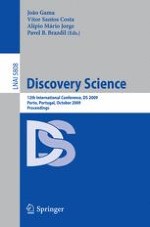2009 | Book
Discovery Science
12th International Conference, DS 2009, Porto, Portugal, October 3-5, 2009
Editors: João Gama, Vítor Santos Costa, Alípio Mário Jorge, Pavel B. Brazdil
Publisher: Springer Berlin Heidelberg
Book Series : Lecture Notes in Computer Science
